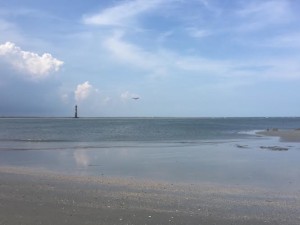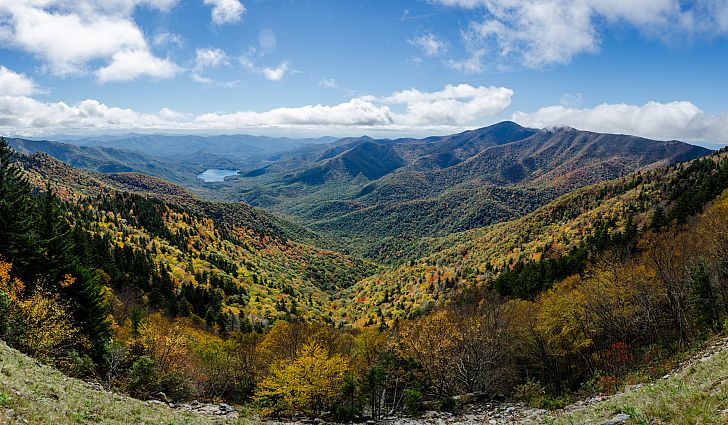Edge of America – A Journey to Morris Island Lighthouse Beach
People talk about the edge of the world or a country all of the time. It’s a way to make it sound amazing, this place where something stops existing and becomes something else, something unknown. Well, I’d like to throw a place into the running for the “Edge of America.”
Folly Beach, Charleston has long been known as the party beach in the area, the lower country’s Myrtle: lots of frat boys, screaming families, a higher concentration of drunk people, etc. It’s one of the reasons people go to Folly. It feels like a vacation there. But if you travel, past the washout, you’ll find a secluded stretch of beach, some woods, and few spectators to block your view of the edge of the world, guarded only by the ghost of a lighthouse.
To access this beautiful beach, you have to drive all the way down to the east end of Folly, park, and walk the remaining quarter of a mile along a paved road. Along your walk, you’ll mostly see foliage indigenous to the area, and a graffiti worn cement platform that tells you that you are almost there. Turn the bend, and you finally see the beach access, which consists of a few dozen yards of incredibly hot sand up and over a dune.
Once you’ve reached the beach though, you couldn’t care less about your scalded toes. This is a different place, a quiet one, where there are only a handful of people, some fishing, some relaxing in the sand; maybe even a photographer or two, taking snapshots of the quiet air. No one swims there because of the incredibly strong rip currents and high likelihood of sharks, but it’s safe enough to sit in the surf, to observe the scuttling blue crabs as schools of fish interrogate your legs and toes with small nips.
A pod of pelicans flying overhead draws your eye out of the water to the horizon, towards the Morris Island Lighthouse, standing several hundred feet offshore. The antebellum monolith was decommissioned in the early ‘60s due to a rising shoreline caused by the construction of jetties earlier in the century. It’s an aging monument, one that has a lot of protection around it, mostly locals who sought to insure its place as a permanent fixture of Folly.
One of the aforementioned jetties partitions the beach, adding to its isolated feel. If you don’t mind getting a little scuffed up from the rocks, then they are a wonderful, if slightly hazardous, vantage point from which to observe the shore and ocean, to reflect, or to take a stunning panoramic photograph with your iPhone. I prefer to watch the ocean wash over the boulders in a baptismal wave, hypnotic in their rhythm, soothing in their sound, and cleansing in their purpose.
 Despite the beauty of this particular section of beach, it is not a crowded place, for many reasons already stated: it’s quite a hike for the casual beach goer, there is no swimming, dogs aren’t allowed as it is also a nature preserve, etc. Some come to kayak, others go on tours of the lighthouse, and there are almost always a few fishermen. But all in all, this strip of the otherwise heavily populated Folly Beach is empty.
Despite the beauty of this particular section of beach, it is not a crowded place, for many reasons already stated: it’s quite a hike for the casual beach goer, there is no swimming, dogs aren’t allowed as it is also a nature preserve, etc. Some come to kayak, others go on tours of the lighthouse, and there are almost always a few fishermen. But all in all, this strip of the otherwise heavily populated Folly Beach is empty.
This is part of the beach’s appeal; its loveliness is not imbued with human activity, and it shows. If you went to any other beach that is normally very busy during off season, you can still tell it’s a popular beach. There are signs everywhere: beach houses hugging the shore, bits of paper, cigarette butts, a uniform shore line.
And of course, humanity has left its mark here as well: the lighthouse, the jetty, even giant sandbags in the surf to aid with erosion. But these things are different than cigarette butts and houses. Cigarettes–and all litter, for that matter–are a sign of constant habitation, replenished daily. Houses are lived in or rented, a flurry of feet, caked with stolen sand, march up the wooden steps into the HVAC and on into the shower, where the sand is rinsed down the drain and into the sewers.
But there is no trace of that here. The closest house is a quarter mile behind you. The lighthouse remains, for most of the year, empty, and the jetties have become a part of the shore, with lichen and clams living on the faces of the rocks. The sandbags, perhaps the least romantic addition, have reached a certain spectral elegance as the raggedy bits undulate in the tide. These are abandoned constructions, and nature has had no problem taking them under her wing.
People go to the beach for many reasons whether that is to hang out with friends, to tan, to swim, to picnic, to fish. And you can do most of those things here, but many don’t. Perhaps it is the haunted feeling that places obtain when humanity withdraws. There is a certain discomfort to it, to sit and stare at a ruin, to watch as humanity and nature coalesce into an oddly perfect pairing.
I just know that as I departed, I couldn’t help but snap a few shots on my iPhone. The initial discomfort gave way to something else, and I wanted a picture to remind me that solitude is the key the rejuvenation, and there is solitude a plenty at the Edge of America.



